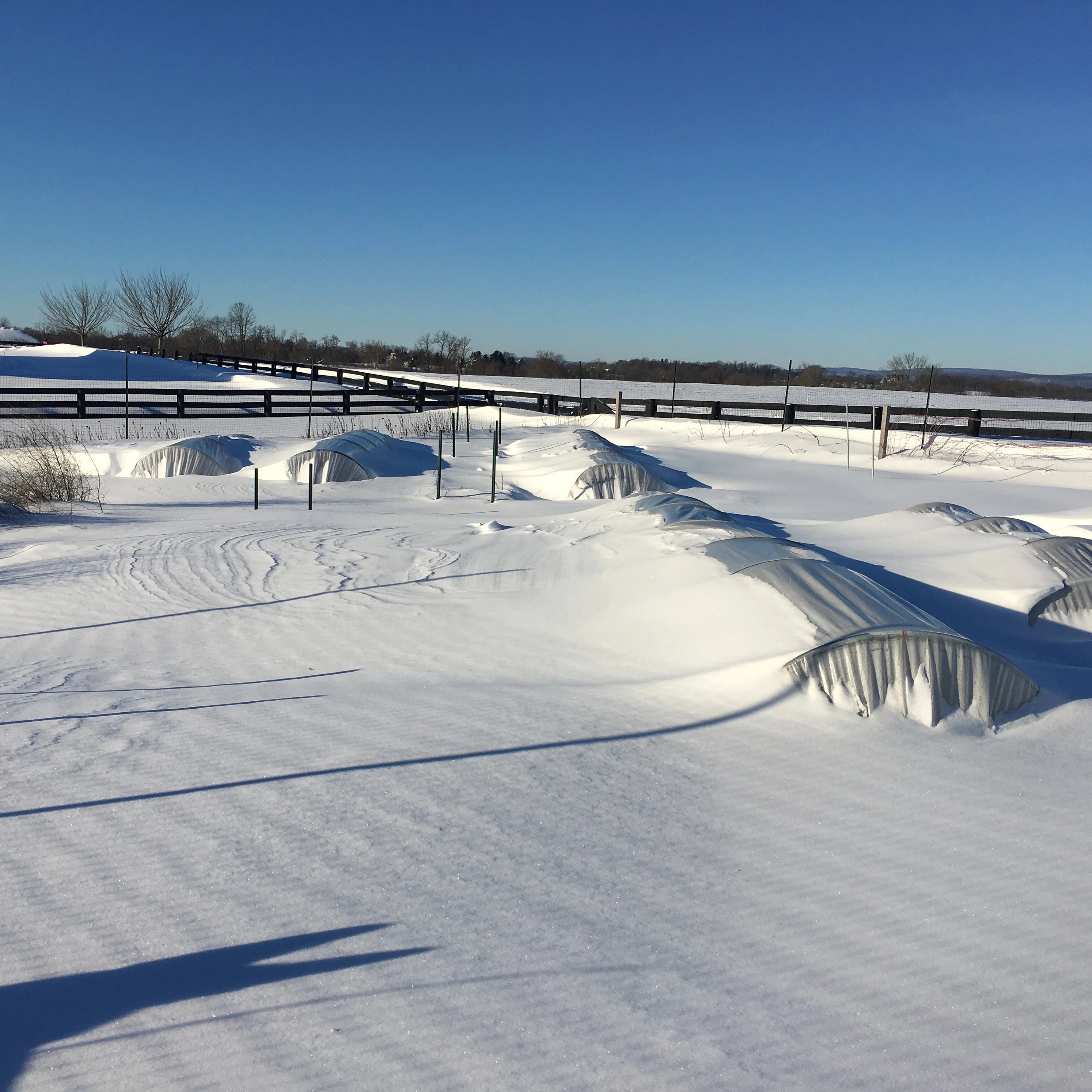Tunnel Vision
Share
Some women pine for a Birken bag, or long for a pair of Louboutins.
I, on the other hand, want a hoop house.
Also known as a high tunnel, or unheated greenhouse, a hoop house is a key tool for extending the growing season. It’s virtually a necessity for the proper cultivation of certain flowers, such as sweet peas, that need months of sunny but cool temperatures to develop the long stems needed for a cut flower. Here in Virginia, those conditions exist for, oh, about five minutes; by the time the hard frosts and harsh winter winds subside, it can be just a few short weeks before sweltering temperatures and humidity hit. A high tunnel solves that problem, enabling the flower farmer to create the perfect conditions for cool season flowers as early as January or February. Then, at the end of the growing season, the tunnels protect those plants that would otherwise succumb to even a touch of frost – such as celosia or zinnias – extending the season for heat-loving plants by weeks, if not months. It can make the difference between having flowers for Thanksgiving, or not.
High tunnels aren’t prohibitively expensive, and there are federal grants that make building them within reach for almost any farmer. So cost isn’t the issue. What is? Well, let’s come back to that…
The poor woman’s version of a hoop house is a low tunnel, sometimes called a caterpillar tunnel because of their segmented appearance. They are relatively inexpensive, can be built in a single day – even by one person, if they know what they’re doing – and have many of the benefits of a high tunnel. I use them to grow ranunculus and anemones, which are otherwise almost impossible to grow in our climate. These flowers, jaw-dropping in their beauty and indispensable for wedding work, need a long period of cool temperatures in which to get established, but cannot tolerate the harsh winter temperatures and wind we experience. And when the warm temperatures of early summer hit, they are done.

I built my first set of caterpillar tunnels using directions provided by Bare Mountain Farm, after seeing a reference to their methodology in Growing for Market, a periodical to which I subscribe. (Both of these resources are indispensable to any flower farmer, by the way. Tony and Denise Gaetz, the farmers behind Bare Mountain Farm in Oregon, are unbelievably generous with their knowledge – check out their web page and series of YouTube videos. Growing for Market was developed by Lynn Byczynski, a flower farmer in Kansas and author of one of the bibles of flower farming called The Flower Farmer: An Organic Grower’s Guide to Raising and Selling Cut Flowers.)
Within weeks of getting my first caterpillar tunnels erected, we were hit by one of the biggest snowstorms the Washington, DC area had seen in years. The tunnels, with anemones, ranunculus, poppies, and other cool season flowers tucked inside, held up great, though it was many days before I could get access to the flowers growing inside in order to check on them.

A winter storm in 2016, affectionately known here in the Washington, DC area as “Snowmageddon,” dumped well over three feet of snow in a short period of time. It took days to dig out, but transformed the scenery around our farm into a spectacular winter wonderland.
Most importantly, the caterpillar tunnels held up beautifully, even though the snowdrifts were almost as high as the tunnels themselves.
What I didn’t count on, however, was how vicious our winds can be. I should have known better, seeing as the farm next door is named Windswept Fields. (You’d think that would have been a clue.) Watching a caterpillar tunnel weather heavy winds is nerve wracking. For someone with a bit of a wind phobia, like me (which I seem to have developed on a trip to the Outer Banks, North Carolina that coincided with a tropical storm that had our rental house -- which was built on stilts, like all of the houses there -- swaying back and forth all night) it is excruciating. In addition to the potential for losing all of the flowers inside the tunnels, my biggest fear is always the idea that the large pieces of plastic that form the tunnels' covering might end up unleashed and make their way, like a gigantic, undulating blob, across the fields and close enough to spook our neighbors’ expensive – and rather twitchy – championship horses.
Of course, one night, that’s almost exactly what happened. On windy nights I sleep restlessly, listening to the wind beat against the house and picturing the tunnels being buffeted by those same winds, bulging out every time a blast of wind makes its way inside the tunnel, then exhaling abruptly when the gust subsides. The sound of the wind hitting all of that plastic is loud and violent, and it is a noise that causes my pulse to rise instantaneously. On that morning, I did what I always do after a night like that: I hold my breath as I jump out of bed to peer out the bedroom window and determine if the tunnels are intact.
That morning, they weren’t. The tunnel that absorbs the brunt of our predominantly westerly winds had failed. While the plastic was still tethered at each end, it had been ripped in two and the 50 foot-long pieces were waving ominously in the wind. I sprinted downstairs, pulled on my insulated overalls and a jacket, grabbed some tools and ran out into the fields. Trying to secure both of the loose ends of the tunnel's plastic was impossible: with the winds still gusting, there was no way to secure even one end, other than pinning it down with my entire body. I pondered this predicament while in this very pose, and then heard a sickening sound. The second tunnel, no longer protected from the worst of the winds by the now-flattened first tunnel, was in the process of failing. Like the buttons popping off a shirt several sizes too small for its wearer, the loops holding down the second tunnel failed in rapid succession, each one breaking with a snapping sound that, within seconds, allowed the metal hoops that form the tunnel’s structure to explode up off the ground and left the tunnel’s plastic free to catch the wind like the sail on a boat. When the violent winds momentarily subsided or changed direction, the heavy plastic would come crashing down, eventually catching on one of the fiberglass rods that, normally, hold the metal hoops in place but now served as a perfect mechanism for creating gashes in the plastic.
And then the third tunnel failed in the same way.
It’s easy to forget how powerful Nature can be. Like the respect I have for the deadly force of an otherwise mesmerizing flow of water down a riverbed – learned while trying my hand at whitewater kayaking many years ago – attempting to wrestle a 100 foot long piece of heavy plastic in a windstorm is like trying to hang on to a dragon’s tail. Several times I felt the sensation of the wind lifting me – via the plastic sail I was holding on to – almost up off the ground. The sensation was both exhilarating and terrifying. I quickly realized there was no way I could get control of more than one piece of plastic at a time, and texted my only employee, who wasn’t due at the farm for several hours, with an SOS. She arrived as quickly as possible, and together we were able to pin down and roll up the plastic pieces. Just lugging each piece of the heavy plastic, now rolled hastily into an unwieldy ball, across the field was strenuous. We threw them into the garage, to be assessed later. Reconstructing the tunnels in that type of wind was completely unfeasible, so the baby ranunculus and anemones would be left unprotected through the rest of the storm. I was completely exhausted, and felt utterly defeated.
Eventually, I re-built the tunnels using some additional techniques gleaned from the construction of larger tunnels (external tie-downs) as well as lots of heavy sandbags, and, so far (knock on wood) they have held up through even worse storms than the ones that brought them down. The ranunculus and anemones also survived (I was able to get several layers of Agribon frost fabric over them, held down by an army of heavy T-posts laid on top). But every time the wind kicks up, I worry. This isn't fun. Especially when the ground is wet... Just pulling the internal frost fabric over the plants, which has to be done any time temperatures are expected to plunge below a certain point, can be an exercise in contortionism.
While effective and relatively inexpensive, caterpillar tunnels are a major pain in the butt. Because they are only a couple of feet high, the ratio of surface area of the ground underneath them vs. the total air volume inside of them is high. That means that they tend to heat up quickly and get much hotter, at least at ground level, than a larger tunnel. That’s fine on a frigid winter day, but it means that highly variable late winter/early spring temperatures – it can be 60 degrees here one day and 20 the next – require constant venting of the tunnels, opening, then closing, then venting again. Unlike high tunnels, for which automatic ventilation systems triggered by a pre-set temperature threshold can be used, a low tunnel requires manual ventilation. Planting and harvesting are also much harder in a caterpillar tunnel, requiring the farmer to bend and crouch into uncomfortable positions in order to gain access to the beds inside. And they are simply too small for some plants, such as sweet peas, zinnias and sunflowers.

This operation, which we – and our neighbors – drive by nearly every day, is not representative of how hoop houses look, but unfortunately, it’s made an indelible impression.
So what’s preventing me from getting a high tunnel? Well, our neighbors – who are good friends of ours – are convinced that hoop houses are horrible eyesores and, in the interests of keeping our friendship intact, we haven’t pushed the issue. It hasn’t helped that a nearby farm, one we both drive by nearly every day, has erected some of the ugliest hoop houses I’ve ever seen -- some only partially built, others with large ventilation fans prominently exposed, and all on a site that is covered in junk of all kinds. It’s an eyesore, no doubt about it.
I haven’t given up yet on convincing our neighbors that hoop houses can indeed be beautiful, or at least not unsightly. Until then, though, I will continue using caterpillar tunnels, crossing my fingers every time the wind picks up, pulling sandbags on and off them constantly in the process of venting, and enduring back cramps induced by crawling in and out of the tunnels to plant, tend and harvest the plants they protect. Why? Because every time I marvel at the perfect swirls of a ranunculus, or harvest an anemone in February -- when everything outside the tunnels is still frigid and brown -- it's all worth it.


